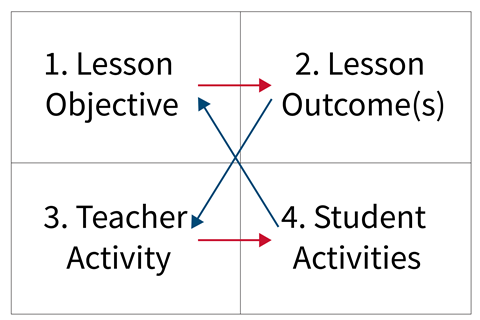Teacher trainer Dom Shibli explains how to create lessons with a logical flow and improve your students’ learning outcomes

Planning lessons is not easy for trainee teachers for many reasons. It takes time and practice to be able to write effective lesson plans – and that is only half the story. Once a lesson plan is written, it then has to be delivered and it is rare that the teacher and the students stick to the script. Teachers are sometimes like the performers in an improvisation club as the students present them with scenarios and dialogue they hadn’t considered. It is important not to underestimate the challenges faced by trainee teachers, but thankfully a good lesson plan can help.
I am going to walk you through a lesson planning process that adopts principles of cognitive science.
I am going to walk you through a lesson planning process that adopts principles of cognitive science which I referred to in a previous article, ‘Remember how we learn’ (LINK).
Focus on outcomes
Experience has shown me that teachers often think about the lesson activities first and then consider the objectives and outcomes. The approach I advocate begins with the learning objective and how this translates into outcomes.

It starts with an objective which must be translated into the subject knowledge and skills before planning the teacher and student activities. This aims to ensure you are focusing on what the pupils are going to learn as opposed to what they are going to do. With this approach, there is a flow through the lesson as you start with the objectives, translate these into outcomes, produce teacher activities that focus on an outcome and then produce activities for the student to carry out. When these activities are finished, check for understanding by referring back to the relevant lesson objective before moving on to the next transition in the lesson. With this framework, you are more likely to maintain a focus on the lesson objectives and write a plan that has a logical sequence – which is often something trainees struggle with.
The lesson plan also becomes a window into a teacher’s mind and can demonstrate whether they have a conceptual understanding of what they are teaching. Identifying the outcomes and writing them down also supports conversations between a trainee teacher and observer to explicitly develop subject knowledge, which trainees often lack.
Download this
A lesson planning framework template to assist you in your planning from the EiC website: LINK
The planning process
This process does not happen in isolation and I recommend you take the following steps:
Stage 1: before the lesson
When thinking about planning a lesson, think about learning as a sequence of lessons and not an individual lesson. Familiarise yourself with the topic by referring to the specification and, if you are teaching outside of your specialism, find resources or colleagues who can help you develop your understanding.
A checklist to consider:
- Identify what you want your students to know by the end of the topic.
- Lessons do not occur in isolation; how does today’s lesson fit into your sequence? Think about what needs to be achieved in today’s lesson that will ensure that the next lesson is more accessible.
- Identify any common misconceptions and explain these explicitly to your students. A classic example in science is the interchangeable use of mass and weight in everyday life: while they can be used in the same topics in science, they are two different concepts that need unpacking.
- Lessons can tell stories and a good explanation can often enhance students’ learning. Providing context in everyday life or sharing something that excites you can strengthen the learning process.
- When you are designing activities for students, make sure the learning purpose of the activity is at the forefront of your mind as opposed to what you want the students to do.
Stage 2: writing the lesson plan
Lesson objective: What do you want the students to learn? When deciding on lesson objectives, avoid multiple objectives to prevent overwhelming students’ working memory. One sentence is often enough to state your intentions, but it needs to be specific to the topic you are teaching and not generic.
Lesson outcome(s): Identify the required knowledge and skills needed to meet the lesson objective and write down which of these the students should know by the end of the lesson. I usually break these down into discrete chunks that I number.
Teacher activity: The teacher activity should relate to the discrete chunks from the learning outcomes, which will create a logical sequence through the lesson. How you choose to translate the subject knowledge in the outcomes is down to you, but use the principles of cognitive science to underpin your decision making.
Student activity: The student activity should reflect the teacher activity and be designed to encourage students to develop an understanding of the lesson objective. The students carry out the activity as designed by the teacher, who will then check understanding against the learning objective. At this point, the teacher then moves on to the next outcome or must adapt their teaching in response to the needs of the students.
|
Lesson objective Sentence to state what the students will learn |
Lesson outcome(s)
The learning objective broken down into discrete chunks 1. 2. 3. |
|
Teacher activity Activity related to outcome 1
|
Student activity Student activity related to outcome 1. Check for understanding against the lesson objective before moving onto lesson outcome 2. |
|
Teacher activity Activity related to outcome 2
|
Student activity Student activity related to outcome 2. Check for understanding against the lesson objective before moving onto lesson outcome 3. |
Stage 3: after the lesson
Review your lesson and use what you noticed to plan your next lesson. Too often reflections are generic and procedural (often focused on behaviour) – so instead focus your reflections on how the students’ responses match the lesson outcomes and use this data to plan your next lesson.
By focusing planning on learning outcomes in this way, your lessons will become more logical, have a natural flow and better support the learning of your students.
Dom Shibli
Downloads
Lesson plan template
Article | Word, Size 0.1 mbLesson plan template
Article | PDF, Size 0.19 mb














No comments yet